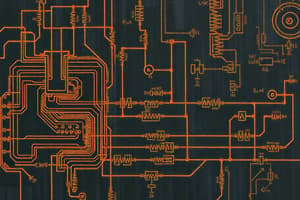Podcast
Questions and Answers
What is the primary function of a resistor in a circuit?
What is the primary function of a resistor in a circuit?
- To oppose the flow of current (correct)
- To store electric charge
- To amplify electronic signals
- To allow current to flow in one direction
Which statement best describes inductors?
Which statement best describes inductors?
- They allow current to flow in one direction only
- They store energy in an electric field
- They are used primarily for lighting circuits
- They store energy in a magnetic field (correct)
In a parallel circuit, how do the voltage and current behave across components?
In a parallel circuit, how do the voltage and current behave across components?
- Voltage is the same; current is divided (correct)
- Voltage is divided; current is the same
- Both voltage and current remain constant
- Both voltage and current are divided
What does Kirchhoff's Voltage Law state?
What does Kirchhoff's Voltage Law state?
Which component is primarily used for converting AC to DC?
Which component is primarily used for converting AC to DC?
What is the role of capacitors in circuits?
What is the role of capacitors in circuits?
How is voltage defined in basic circuit concepts?
How is voltage defined in basic circuit concepts?
What is the relationship defined by Ohm's Law?
What is the relationship defined by Ohm's Law?
Flashcards
Resistors
Resistors
Passive components that oppose the flow of electrical current. They are measured in ohms (Ω).
Capacitors
Capacitors
Passive components that store electrical energy in an electric field. Measured in farads (F), but often in microfarads (µF) or picofarads (pF) to represent smaller values.
Inductors
Inductors
Passive components that store energy in a magnetic field when current flows through them. Measured in henries (H).
Diodes
Diodes
Signup and view all the flashcards
Transistors
Transistors
Signup and view all the flashcards
Ohm's Law
Ohm's Law
Signup and view all the flashcards
Kirchhoff's Voltage Law (KVL)
Kirchhoff's Voltage Law (KVL)
Signup and view all the flashcards
Kirchhoff's Current Law (KCL)
Kirchhoff's Current Law (KCL)
Signup and view all the flashcards
Study Notes
Basic Components
- Resistors: Passive components that oppose the flow of current. Measured in ohms (Ω). Resistors can be fixed or variable (potentiometers). They are used to limit current, divide voltage, and create bias circuits among other functions.
- Capacitors: Passive components that store electric charge. Measured in farads (F), but often in microfarads (µF) or picofarads (pF). They have an ability to block DC but allow AC components to pass. Capacitance is affected by the material between the plates and the area of the plates.
- Inductors: Passive components that store energy in a magnetic field when current flows through them. Measured in henries (H), and are often used in filters, transformers, and RF circuits.
- Diodes: A semiconductor device that allows current to flow in one direction but not the other. Commonly used in rectifier circuits for converting AC to DC.
- Transistors: Semiconductor devices used for amplifying or switching electronic signals and power. Examples include bipolar junction transistors (BJTs) and field-effect transistors (FETs). Transistors drastically enhance the control and switching capability of circuits.
Basic Circuit Concepts
- Voltage (V): Electrical potential difference. Measured in volts (V).
- Current (I): Flow of electric charge. Measured in amperes (A).
- Resistance (R): Opposition to current flow. Measured in ohms (Ω).
- Ohm's Law: The fundamental relationship between voltage, current, and resistance: V = IR.
- Kirchhoff's Voltage Law (KVL): The sum of voltages around any closed loop in a circuit is zero.
- Kirchhoff's Current Law (KCL): The sum of currents entering a junction in a circuit is equal to the sum of currents leaving the junction.
- Series Circuits: Components are connected end-to-end. Current is the same through all components, while voltage is divided among them.
- Parallel Circuits: Components are connected across each other (all components have the same voltage). Current is divided among components, while voltage is the same across all of them.
- Ground: A reference point in a circuit, usually connected to the earth. It is typically assigned a voltage of zero.
Basic Circuit Analysis
- DC circuits: Circuits with a constant voltage source. Analysis involves employing Ohm's law along with Kirchhoff's Laws to calculate voltages, currents and resistances.
- AC circuits: Circuits with a time-varying voltage source. Analysis involves the concept of impedance (which includes resistance, inductance, and capacitance). Frequency characteristics determine the circuit's response.
- Filters: Circuits that allow certain frequencies to pass while attenuating others. Types include low-pass, high-pass, band-pass, and band-reject.
Analog vs. Digital
- Analog circuits: Employ continuously varying signals (e.g., voltage, current). More sensitive to noise.
- Digital circuits: Use discrete signals (e.g., binary: on/off). Less susceptible to noise, better for computation.
Safety Precautions
- Always disconnect power before working on any circuit.
- Be mindful of voltage and current levels.
- Properly handle components to prevent damage.
- Use appropriate safety equipment such as gloves, eye protection, and insulated tools.
Studying That Suits You
Use AI to generate personalized quizzes and flashcards to suit your learning preferences.




